POUR TOUT RENSEIGNEMENT SUPPLÉMENTAIRE SUR CET OUTIL OU TOUT AUTRE
OUTIL D
EWALT, COMPOSER SANS FRAIS LE NUMÉRO:
1 800 4-DEWALT (1 800 433-9258)
RÈGLES DE SÉCURITÉ GÉNÉRALES
AVERTISSEMENT! Vous devez lire et comprendre toutes les instructions. Le non-
respect, même partiel, des instructions ci-après entraîne un risque de choc électrique, d’in-
cendie et/ou de blessures graves.
CONSERVEZ CES INSTRUCTIONS.
AIRE DE TRAVAIL
Veillez à ce que l’aire de travail soit propre et bien éclairée. Le désordre et le manque de
lumière favorisent les accidents.
N’utilisez pas d’outils électriques dans une atmosphère explosive, par exemple en
présence de liquides, de gaz ou de poussières inflammables. Les outils électriques
créent des étincelles qui pourraient enflammer les poussières ou les vapeurs.
Tenez à distance les curieux, les enfants et les visiteurs pendant que vous travaillez
avec un outil électrique. Ils pourraient vous distraire et vous faire faire une fausse manoeu-
vre.
SÉCURITÉ ÉLECTRIQUE
Les outils mis à la terre doivent être branchés dan une prise de courant correctement
installée et mise à la terre conformément à tous les codes et règlements pertinents.
Ne modifiez jamais la fiche de quelque façon que ce soit, par exemple en enlevant la broche
de mise à la terre. N'utilisez pas d'adaptateur de fiche. Si vous n'êtes pas certain que la prise
de courant est correctement mise à la terre, adressez-vous à un électricien qualifié. En cas
de défaillance ou de défectuosité électrique de l'outil, une mise à la terre offre un trajet de
faible résistance à l'électricité qui autrement risquerait de traverser l'utilisateur. Valable seule-
ment pour les outils de classe I (mis à la terre). Les modèles DW274W et DW286G sont mis
à la terre.
Les outils à double isolation sont équipés d’une fiche polarisée (une des lames est
plus large que l’autre), qui ne peut se brancher que d’une seule façon dans une prise
polarisée Ne modifiez pas la fiche de l’outil. La double isolation élimine le besoin
d’un cordon d’alimentation à trois fils avec mise à la terre ainsi que d’une prise de
courant mise à la terre. Valable seulement pour les outils de classe II (à double isolation).
Les modèles DW251, DW252, DW255, DW257, DW260, DW262, DW263, DW265, DW266,
DW266-220, DW267, DW268, DW268-220, DW269, DW272, DW274, DW274-220, DW276,
DW276-220, DW281, DW282 et DW284 comportent une double isolation.
Évitez tout contact corporel avec des surfaces mises à la terre (tuyauterie, radiateurs,
cuisinières, réfrigérateurs, etc.). Le risque de choc électrique est plus grand si votre corps
est en contact avec la terre.
N’exposez pas les outils électriques à la pluie ou à l’eau. La présence d’eau dans un outil
électrique augmente le risque de choc électrique.
Ne maltraitez pas le cordon. Ne transportez pas l’outil par son cordon et ne débranchez
pas la fiche en tirant sur le cordon. N’exposez pas le cordon à la chaleur, à des huiles, à des
arêtes vives ou à des pièces en mouvement. Remplacez immédiatement un cordon endom-
magé. Un cordon endommagé augmente le risque de choc électrique.
Lorsque vous utilisez un outil électrique à l’extérieur, employez un prolongateur pour
l’extérieur marqué «W-A» ou «W». Ces cordons sont faits pour être utilisés à l’extérieur et
réduisent le risque de choc électrique. S’assurer que le cordon de rallonge est en bon état.
Lorsqu’on se sert d’un cordon de rallonge, s’assurer qu’il est de calibre approprié pour la ten-
sion nécessaire au fonctionnement de l’outil. L’utilisation d’un cordon de calibre inférieur
occasionne une baisse de tension entraînant une perte de puissance et la surchauffe. Le
tableau suivant indique le calibre approprié selon la longueur du cordon et les mentions de
la plaque signalétique de l’outil. En cas de doute, utiliser un cordon de calibre supérieur. Le
chiffre indiquant le calibre est inversement proportionnel au calibre du cordon.
Calibre minimal des cordons de rallonge
Tension Longueur totale du cordon en pieds
120 V 0-25 26-50 51-100 101-150
Intensité (A)
Au Au Calibre moyen de fil (AWG)
moins plus
0-6 18161614
SÉCURITÉ DES PERSONNES
Restez alerte, concentrez-vous sur votre travail et faites preuve de jugement. N’utilisez
pas un outil électrique si vous êtes fatigué ou sous l’influence de drogues, d’alcool ou de
médicaments. Un instant d’inattention suffit pour entraîner des blessures graves.
Habillez-vous convenablement. Ne portez ni vêtements flottants ni bijoux. Confinez
les cheveux longs. N’approchez jamais les cheveux, les vêtements ou les gants des
NOTE: Align ribs on inside of depth locator with grooves in clutch housing before snapping into
place.
CHANGING BIT TIP
1. Pull forward on adjustment collar and remove it from clutch housing (see Figure 3).
2. Use pliers to remove worn bit and install new bit tip.
DEPTH ADJUSTMENT:
Follow the graphic on the collar to increase or decrease the fastening depth. To seat the screw
deeper in the workpiece, turn the adjustment collar to the right. To seat the screw higher in the
workpiece, turn the adjustment collar to the left.
Nutsetting Units (DW260, DW263, DW266, DW266-220)
INSTALLING AND CHANGING NUTSETTERS AND LOCATORS
Depth Sensitive Units for Drill Point Screws
1. To change or install a new nutsetter:
a) Pull forward on adjustment collar and remove from clutch housing.
b) Pull nutsetters straight out with pliers
c) Select nutsetter size desired.
d) Two locators are supplied, a 9/16" ID for 3/8" nutsetters and 1/2" ID for 5/16" nutsetters.
Match locator to desired size nutsetter or bit holder.
2. Place nutsetter into clutch housing and push end of nutsetter until ball lock snaps into groove
of nutsetter shank.
3. Reassemble adjustment collar by snapping over springs (see Figure 4).
NOTE: Align ribs on inside of depth locator with grooves in clutch housing.
DEPTH ADJUSTMENT
1. For washer head screws: rotate adjustment collar until end of nutsetter is flush with end of
locator.
2. For large washer head and sealer screws: adjust as above until nutsetter is recessed
approximately 1/16" into the locator.
3. Test drive a fastener in scrap material to determine if seating is correct.
4. Adjust following the graphic printed on the tool.
VERSA CLUTCH™ UNITS (DW267, DW268, DW268-220, DW268G, DW269)
External adjustment of all Versa Clutch™ units for a wide range of fastener sizes is fast and easy
as follows (see Figure 5):
1. Pull forward, then rotate collar in increase direction (stamped on adjustment collar) to
increase the amount of clutch engagement and torque output.
2. Maximum rotation of the collar in the increase direction results in full clutch engagement and
maximum torque output and fastener capacity. Collar and adjustable stop will not screw off
clutch housing.
3. Test drive a fastener into a scrap piece to check proper fastener seating. It is normal after a
period of use to require a slightly different collar setting due to wear on the clutch faces.
NOTE: With Versa Clutch™, the operator has the ability to “override” clutch ratchet if a fastener
hits a wood knot, variable hardness in steel work pieces or incorrect pilot holes. Increased operator
pressure will usually cause the clutches to pick-up and continue to seat the fastener. Further, a
quick twist of the collar will change the clutch setting to overcome most driving difficulties and will
provide for immediate change in torque output giving the operator the option to drive a wide range
of fastener sizes.
Positive Clutch Units (DW281, DW282, DW284)
1. Install proper bit and set screwdriver for correct rotation.
2. Place fastener on bit and contact work.
3. Apply steady pressure on screwdriver to keep clutches engaged and bit in contact with fas-
tener.
4. Upon fastener seating, clutches will ratchet. Disengage bit from fastener.
Maintenance
CLEANING
With the motor running, blow dirt and dust out of all air vents with dry air at least once a week.
Wear safety glasses when performing this operation. Exterior plastic parts may be cleaned with
a damp cloth and mild detergent. Although these parts are highly solvent resistant, NEVER use
solvents. Drywall Screwdrivers: Depth locator and adjustment collar should be removed and
drywall dust blown out of the clutch housing area at least once a week.
CHANGING CLUTCHES
1. Remove clutch housing by unscrewing (left hand thread).
2. Clamp tool or clutch housing in a resilient clamp.USE CARE, the clutch housing can be
easily damaged.
3. Remove round clutch retaining rings with a very small screwdriver (see Figure 6).
4. Install new clutches and new retaining rings. (DW274 series only) Be careful to assemble
the intermediate clutch large end first toward the unit and then the spring. The spring should
run against the output clutch.
NOTE: If the output spindle slides toward inside of gear case, remove gear case and push out-
put spindle forward to expose retaining ring groove. Reassemble dead spindle spring allowing
no more than 1/4" projecting from end of spindle.
5.Relubricate clutches (see Parts Bulletin for D
EWALT lubricants identification).
LUBRICATION
All ball and needle bearings are factory lubricated for the life of the bearing.
CLUTCH LUBRICATION
1. Remove clutch housing by unscrewing (left hand thread).
2. Lightly brush clutch faces.
Accessories
Recommended accessories for use with your tool are available at extra cost from your distributor
or local service center.
CAUTION: The use of any non-recommended accessory may be hazardous.
Repairs
To assure product SAFETY and RELIABILITY, repairs, maintenance and adjustment (including
brush inspection and replacement) should be performed by authorized service centers or other
qualified service organizations, always using identical replacement parts.
Three Year Limited Warranty
DEWALT will repair, without charge, any defects due to faulty materials or workmanship for three
years from the date of purchase. This warranty does not cover part failure due to normal wear
or tool abuse. For further detail of warranty coverage and warranty repair information, visit
www.dewalt.com or call 1-800-4-D
EWALT (1-800-433-9258). This warranty does not apply to
accessories or damage caused where repairs have been made or attempted by others. This
warranty gives you specific legal rights and you may have other rights which vary in certain
states or provinces.
In addition to the warranty, D
EWALT tools are covered by our:
1 YEAR FREE SERVICE
D
EWALT will maintain the tool and replace worn parts caused by normal use, for free, any time
during the first year after purchase.
90 DAY MONEY BACK GUARANTEE
If you are not completely satisfied with the performance of your D
EWALT Power Tool, Laser, or
Nailer for any reason, you can return it within 90 days from the date of purchase with a receipt
for a full refund – no questions asked.
FREE WARNING LABEL REPLACEMENT: If your warning labels become illegible or are miss-
ing, call 1-800-4-DEWALT for a free replacement.
FIG. 2
FIG. 1
FIG. 3
220 VOLT
.
.
.
.
.
.
.

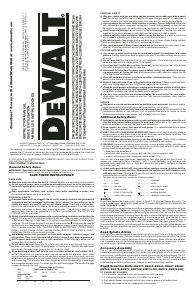


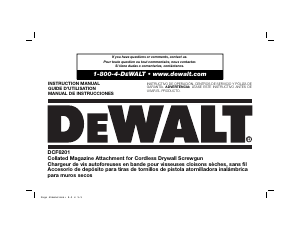
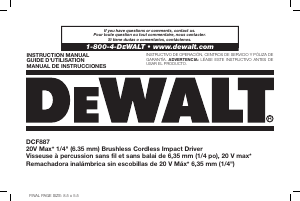
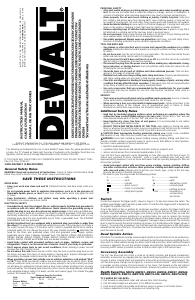
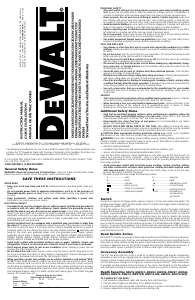
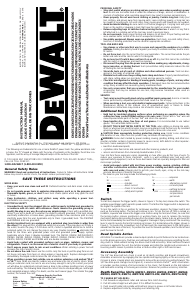
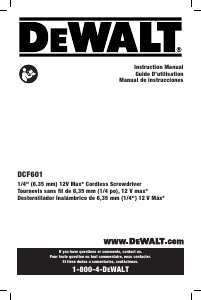

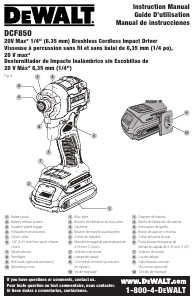
Únase a la conversación sobre este producto
Aquí puedes compartir lo que piensas sobre DeWalt DW269 Atornillador. Si tiene alguna pregunta, primero lea atentamente el manual. Puede solicitar un manual utilizando nuestro formulario de contacto.